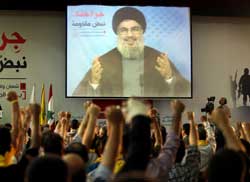Hezbollah’s Syrian jihad
The civil war in Syria could spark renewed war in Lebanon, warns Anthony Tucker-Jones, with Hezbollah poised to escalate its involvement
The recent Battle of Qusair served to highlight Lebanese Hezbollah’s expanding role in the Syrian crisis. There have been rumours of Hezbollah fighters in Syria since the start of the uprising, and they are reported to have helped the Syrian army recapture Qusair in early June this year. Hezbollah’s leader Hassan Nasrallah committed at least a brigade to this battle, which will have greatly assisted the Syrian army. Hezbollah fighters have also been in action supporting Shi’ite communities in the Homs province and resisting the Free Syrian Army (FSA) at the Shi’ite shrine at Sayyida Zeinab on the southern outskirts of Damascus.

Hezbollah, or the “Party of God”, has long been a force to be reckoned with in neighbouring Lebanon. This Shi’ite Lebanese organisation enjoys the patronage of Shi’ite Iran. It came into being following Israel’s invasion of southern Lebanon in 1982, when the Israelis sought to drive the Palestinian Liberation Organisation from Beirut. It remains the sworn enemy of Israel and its Western allies. Some countries, including the US, consider Hezbollah as a terrorist organisation, though it functions both as a political party and a military entity.
Hezbollah has been supplied for its struggle against Israel by Iran via Syria, so Nasrallah considers the Shi’ite Alawite regime of Bashar al-Assad a key regional ally. Until Syria’s withdrawal from Lebanon in 2005, Hezbollah and the Syrian military sat side by side in the Bekaa valley.
Israel’s military and intelligence leaders must be rubbing their hands together with glee. A traditional enemy that has rained misery down on northern Israel and sparked a war in 2006 has now diverted its attentions elsewhere. Since that conflict, Hezbollah has slowly been amassing weapons – particularly rockets – in preparation for its next confrontation with the Israeli Defence Forces. But now it is capable of deploying those weapons against a new enemy.
The Israelis fought a brief war with Hezbollah in southern Lebanon in mid-2006, which saw Israeli tanks and armoured personnel carriers push across the border. This was the first time the Israeli Merkava IV tank, which was just entering service, saw combat, though only in limited numbers. The Israelis found themselves fighting an asymmetrical war. Although the lightly equipped Hezbollah lacked tanks, its anti-tank arsenal included the RPG-29 Vampir, AT-5 Konkurs, AT-13 Metis-M and AT-14 Kornet missiles – all of which can be deadly to armoured vehicles.
As a result, the Israeli tank crews suffered quite heavily. Five Merkava IVs had their armour penetrated by such missiles, with ten crew members killed. Another Merkava IV drove over an improvised explosive device (IED) and the blast killed a crewman. About 50 Merkavas, mainly the earlier MK IIs and IIIs, were damaged. Two MK IVs were write-offs, having been hit by an AT-14 and an IED, while the rest were repaired and returned to service.
Two years later, Hezbollah fell out with the Lebanese government, which led to sectarian fighting in west Beirut, Sidon, Tripoli and Mount Lebanon. The Lebanese army was forced to intervene and, although order was restored, old blood feuds were resurrected. The Shi’ites hold sway in southern Lebanon and, crucially, in the north east, in the Bekaa valley around Baalbek. This puts Hezbollah right up against the border with central Syria, facing the towns of Nabk and Qusair.
Nasrallah argues that if the Syrian Sunni rebels oust the Alawites, this will pose a threat to Lebanon. This is not necessarily true; but it will pose a threat to Hezbollah and will cut off its Iranian supply route through Syria. Israel continues to be uneasy about the symbiotic relationship between Damascus and Hezbollah. This led to two Israeli air strikes in January and May on Syrian missiles purportedly destined for Hezbollah. As well as supporting Hezbollah, Iran has reportedly been bankrolling, training and equipping Assad’s recently formed Popular Committee militias, which are working independently of the hated pro-regime Shabiha militia.
No one is really certain about the fighting strength of Hezbollah and this is certainly something it does not advertise. Some estimates claim it can call on up to 10,000 volunteers, but only 1,000 of these are full-time fighters. According to Iranian media sources, Hezbollah has up to 65,000 fighters, but such a figure seems highly fanciful. What Hezbollah is well equipped with is rockets and missiles, as well as anti-tank weapons. These have been assembled with the intention of targeting the Israelis, but some could be redeployed into Syria.
Nasrallah was keen to help drive the FSA from Qusair because he wanted to push them away from the border. For President Assad, the FSA’s presence was an obstacle between the Alawite heartland on the Syrian coast to the north and Damascus to the south. In addition, the town is not far from the strategic north-south highway that goes all the way north to Aleppo.
General Selim Idriss of the FSA claimed that over 7,000 Shi’ite Lebanese fighters had been involved in the operation against Qusair. The French Foreign Ministry put the figure nearer 4,000; either way, this was not an inconsiderable fighting force. Iranian state television was fulsome with its praises for Hezbollah for “turning the table after three years of war”. The US State Department has since demanded that Hezbollah withdraw from Syria, but it has no leverage over the organisation.
Lebanon is a fragile country that has been traumatised by decades of bloody and senseless violence. Now, it is once more teetering on the brink of civil war. Lebanon’s Shi’ite and Sunni Muslim communities support opposing sides in the Syrian conflict, which is inevitably putting pressure on the country’s religious and political fault lines. The fear is that Hezbollah’s involvement in Syria will open up old wounds. The country’s Alawites, Christians (Armenian and Greek Catholic and Marionites), Druze, Shi’ites and Sunnis are alarmed at the prospect of the country’s patchwork quilt of religions coming apart at the seams once again.
Indeed, members of the March 14 Alliance and the smaller Shi’ite Lebanese Option Party oppose Hezbollah’s intervention. The March 14 Alliance is a grouping of more than a dozen different Lebanese secular and religious parties which are anti-Syrian. At the same time, Lebanese Sunnis have also been joining the fight alongside the FSA. The Lebanese people cannot understand why the Lebanese army does not seal off the border and prevent Hezbollah slipping into Syria. The Lebanese army, however, has its hands full with trying to keep an eye on almost 30,000 Syrian refugees, many of whom are FSA supporters, and keeping apart the various sectarian factions.
General Idriss has warned that the FSA is prepared to take the war to Hezbollah inside Lebanon. He said: “There are now a very large number of Hezbollah fighters in Syria, in Qusair, in Idlb, in Aleppo, in Damascus and I can say everywhere in the country. Hezbollah fighters are invading Syrian territory. And when they continue to do that and the Lebanese authorities don’t take any action to stop them coming to Syria, I think we are allowed to fight Hezbollah fighters inside Lebanese territory.”
There have already been sectarian clashes between pro and anti-Assad demonstrators in Lebanon. In early June, there was violence between Syrian rebels and Hezbollah near Baalbek in which 15 people were killed. According to the Lebanese media, FSA supporters are preparing to fire rockets at Hezbollah targets in Lebanon in revenge for its support for Assad. Rockets have already been fired into the Baalbek area. Lebanese Sunnis have also been voicing their displeasure with Iran. A recent demonstration outside the Iranian Embassy in Beirut turned sour, leaving at least one man dead.
While Hezbollah has not really been considered an international player, in recent years it has been accused of conducting attacks on Israelis in Turkey and Bulgaria as well as attempting an attack in Cyprus. Hezbollah’s international meddling has even extended as far as Nigeria. In late May, the Nigerian army arrested three Lebanese nationals and discovered weapons in the city of Kano believed to belong to Hezbollah. Nigeria’s State Security Service stated that the cache of assault rifles, submachine guns and anti-tank mines had been gathered for attacks on Israeli and Western interests. This is the first time that Hezbollah has acted operationally in Nigeria and the concern is that it is seeking to co-operate with the Nigerian Islamist group Boko Haram.
There is speculation that Hezbollah’s involvement in Syria may do it long-term harm. Maintaining large numbers of men in the field is a costly business and a constant drain on resources. Reportedly, Hezbollah fighters were doing a week on and a week off, and this has now been extended to 20 days’ active duty. Some Hezbollah leaders will undoubtedly be worried that the organisation’s expanding role in Syria is distracting from its confrontation with Israel. While weapons stocks can be replenished, little can be done about manpower losses.
Nonetheless, Hezbollah’s Syrian jihad and its commitment to Assad show no sign of abating. Following the recapture of Qusair, Hezbollah committed another brigade-strength force to the fighting around Aleppo. And ultimately, Assad needs all the friends he can muster.
Anthony Tucker-Jones is intersec’s terrorism and security correspondent. He is a former defence intelligence officer and is now a widely published defence commentator specialising in regional conflicts and counter-terrorism







